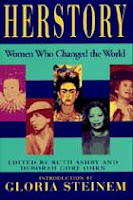 Herstory: Women Who Changed The World edited by Ruth Ashby and Deborah Gore Ohrn is copyrighted 1995, which makes me wonder who would be included in an updated volume.
Herstory: Women Who Changed The World edited by Ruth Ashby and Deborah Gore Ohrn is copyrighted 1995, which makes me wonder who would be included in an updated volume.Ever since high school I've identified myself as a feminist, and women's history and women's rights are near and dear to me. The marginalization, objectification, discrimination, and second class citizenship of women throughout history are ideas that still outrage and horrify me when I read about the obstacles, injustices and perils that my female forebears have had to overcome and survive to get to where we are today. I may not have personally experienced these struggles--I have come of age in the title IX era where equality or near equality is the only thing I've known--but I am acutely aware of the fairly recent period in history in which women had few or no rights and how fragile those rights remain with the current Republican president and the addition of two conservative justices to the U.S. Supreme Court. A patron of the library recently reserved a copy of this book and when it came in for her, I saw it and placed my own request for it.
Herstory is a volume of brief biographies of women including, but not limited to, Hatshepsut, Empress Theodora, Artemisia Gentileschi, the Grimke sisters, the Bronte sisters (one quibble I had with the book: only Charlotte and Emily were featured, when Anne was also an accomplished writer in her own right and deserved mention as well), Antoinette Brown Blackwell, Mary Cassat, Ichikawa Fusae, and Wilma Mankiller. One thing that stunned me were the familial relationships between quite a few of the women listed in the nineteenth century--for example, Antoinette Brown Blackwell was the sister-in-law of Elizabeth Blackwell, the first female physician in America. These are often remarkable stories of society's marginalized citizens who managed to rise above this status to make names for themselves and advancements in their fields. Women from prehistoric to modern times, who contributed to advancements in women's rights, education, reforming labor laws, as well as performed brilliant work in fields ranging from the arts to politics to chemistry, physics, anthropology and ecology. Noted feminists, such as Elizabeth Cady Stanton, Susan B. Anthony, and Betty Friedan, who worked for women's enfranchisement, equality and reproductive rights are also listed. Each section includes an overview of the developments of the historical periods in which these women lived and worked.
Until today's history books represent women as much as they do men, I think this volume or one like it should be included on every student's reading list.
This book is available upon request from Lebanon and Myerstown Community Libraries. I highly recommend you check it!
--reviewed by Ms. Angie
Comments